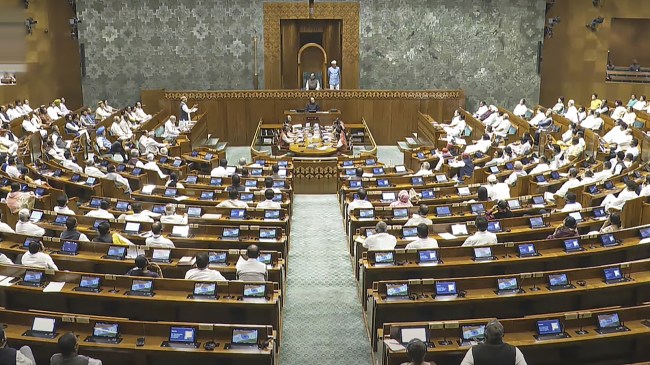Opinion Op Sindoor debate reaffirmed a republic unafraid to question and challenge
In the final reckoning, Sindoor may come to symbolise many things: Tactical audacity, calibrated resolve, and the emergence of a more assertive India
 Members of the Treasury benches on the left and the Opposition on the right during proceedings in Lok Sabha on Monday. (ANI)
Members of the Treasury benches on the left and the Opposition on the right during proceedings in Lok Sabha on Monday. (ANI) The debate on Operation Sindoor did not rest on pleasantries. Sixteen hours of verbal combat in Parliament — impassioned, insightful, much of it revealing, followed India’s precision retaliation to the brutal Pahalgam terror attack. Operation Sindoor was a moment of muscular assertion. But what followed in Parliament was no less critical: A vibrant, at times strident, affirmation that India’s democracy has the spine to scrutinise even its sharpest sword. This was no ordinary debate. It was as much a test of India’s strategic reflexes as it was of its democratic sinews.
The strikes themselves were extraordinary. Coordinated across air and ground, targeting more than 100 terror-linked assets, they sent a message not just to Pakistan, but to the wider region. And yet, the Opposition was not content with applause. It demanded answers. Why had intelligence failed to prevent the Pahalgam massacre? What were the exact terms of engagement? And, crucially, were President Donald Trump’s repeated claims that he had “halted” the offensive and the claim that Indian jets were downed entirely baseless? These were not seditious questions. They were democratic ones. In a mature republic, strength is not demonstrated through denial, but through debate. It is here that India revealed the deeper character of its political culture.
To its credit, the government did not flinch. The Defence Minister laid out the operational contours of the strike. The External Affairs Minister dismantled Trump’s outlandish claim that he had halted Indian jets through a call that never occurred.
The Prime Minister, often accused of strategic silence, spoke with gravitas and lucidity: Combining what was described privately by one Opposition leader as “steel with statesmanship”, he affirmed that the armed forces had been accorded full operational autonomy in choosing the moment, method, and magnitude of Operation Sindoor. The result: A calibrated, 22-minute retribution that crippled terror-linked targets. He categorically dismissed the notion of foreign mediation. No leader had restrained India; Pakistan had sought reprieve, not the world. Atmanirbhar Bharat, he declared, is no slogan — it is doctrine. With defence exports spanning over 100 nations, India is shedding dependence and asserting sovereign capability. Finally, in an oratorical flourish that resonated across party lines, he enunciated a new red line: The distinction between terrorists and their sponsors has dissolved, both will be met with unflinching reprisal. And yet, the shadows lingered.
Trump’s assertions were diplomatically offensive and factually absurd. But in the echo chamber of global perception, even fiction can acquire dangerous resonance. India’s delay in demolishing the claim ceded narrative ground not on the battlefield, but in the global imagination. In today’s strategic environment, perception is as potent as projection. And information is now the fourth domain of warfare.
Operation Sindoor thus reveals two intertwined facets of India’s emerging strategic identity: A capacity to strike with technical finesse and political will, and a parallel maturity to subject those strikes to democratic scrutiny. In a region where strongmen muzzle dissent and silence Parliament, India demonstrated that a strong Prime Minister and a questioning legislature can co-exist, not in contradiction, but in creative tension.
Let us mark five enduring lessons from this episode — shaped not only by military strategy but also by the intensity of parliamentary debate. First, the China-Pakistan nexus is no longer theoretical. It is operational. The coordination in disinformation, drone surveillance, and military posturing points to an emerging twin-front hybrid challenge. India must rethink its security architecture through this prism. Deterrence must evolve from episodic retaliation to a holistic, two-theatre posture.
Second, intelligence remains our Achilles’ heel. The tragedy of Pahalgam was not merely the loss of life. It was the failure of foresight. India’s intelligence architecture is still over-centralised, turf-ridden, and reactive. Reform must focus on fusing human and technological capabilities, decentralising decision-making, and enabling predictive analytics.
Third, doctrine must replace demonstration. Sindoor, like Balakot and Uri before it, was tactically impressive. But deterrence is not built on episodic fireworks. It requires strategic clarity. If we are now in the domain of preemptive, precision operations, the red lines, thresholds, and strategic aims must be publicly understood, if not fully disclosed.
Fourth, narrative sovereignty must be institutionalised. The Trump distraction was not just a media sideshow. It was a revelation of our unpreparedness in the information war. In the age of social media and disinformation, speed and credibility of messaging are as vital as stealth and strength. India must build strategic communication infrastructure that can speak with authority, agility, and global reach.
Fifth, Parliament must become a permanent participant in national security discourse. The Sindoor debate was heartening in being largely civil and substantial. There were no walkouts, no partisan shouting matches, not even many monopoly claims on patriotism. Even the sharpest critics acknowledged the professionalism of the armed forces and the necessity of the strike. What they demanded was transparency, institutional learning, and strategic foresight. That demand must now be met with structure. A standing bipartisan committee on national security, empowered with briefings, oversight, and consultative authority, can bridge the gap between operational secrecy and democratic responsibility. In choosing to deliberate, not defer, Parliament reminded us that scrutiny is not the enemy of strength, but its most durable companion.
In the final reckoning, Sindoor may come to symbolise many things: Tactical audacity, calibrated resolve, and the emergence of a more assertive India. But its true significance lies in what followed. A vibrant Parliament, diverse, cacophonous yet conscientious, rose to the challenge of testing statecraft with scrutiny. It did not defer to secrecy, nor did it descend into spectacle. Instead, it engaged. And in doing so, it reaffirmed to the world that India’s strength does not lie in authoritarian silence but in argumentative democracy.
In that sense, the real triumph was not just the success of Sindoor, but the maturity of the republic. India struck. India debated. And in doing both, India reaffirmed its character — not merely as a strategic actor, but as a polity that is as thoughtful as it is forceful not merely as a rising power, but as a thinking republic.
Let others strike in silence. India, still loud, still argumentative, still proud, walks a different path, where the sword and the sceptre speak to each other. That is the Indian idea. And it is, still, worth believing in and with passion.
The writer is dean and professor, School of International Studies, JNU, and former member of India’s National Security Council’s Advisory Board



